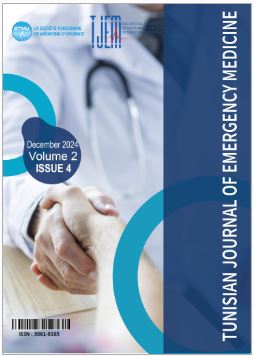Traditional Medicine with Cade Oil in Pediatric Emergency Care
Faiza SAFI1,3,4, Asma BAATI1,3,4, Manel FEKI1,2,3, Malek ZRIBI2,3,4, Mariem MEDHIOUB1,3,4, Mariem JMAL1,3,4, Ayman DAMMAK3,4, Mouna LOUKIL,3,4
- Authors
-
-
Faiza Safi
,
-
- Abstract
-
Despite the advancements in modern medicine, traditional medicine remains relevant in our country. This is exemplified by the practice of traditional therapy using cade oil, commonly referred to as "camel soap," "tar," or "القطران," which is increasingly observed in Tunisia. It is not uncommon to admit patients to the hospital who are victims of these practices.
We conducted a prospective study over a 6-year period from January 2018 to December 2023. We included newborns, infants, and children under 14 years of age who had undergone traditional therapy with cade oil. We excluded all other forms of traditional therapy.
The aim of our study was to raise awareness of the increasing frequency of cade oil traditional therapy in our region, the potential damages that can result, and the importance of taking appropriate medical and legislative measures to address this phenomenon.
Twenty cases were recorded in our department for this reason. All children had a low socioeconomic status. Thirteen were from rural areas and seven from urban areas. The reasons for resorting to these practices included lack of resources in one case, and in all other cases, parental beliefs in the effectiveness of these methods compared to modern treatments. The average interval between the application of cade oil and consultation at the hospital was 14 hours. The average age was 18 months, with a minimum age of 10 days and a maximum of 4 years. The primary reason for consultation was gastrointestinal symptoms, including diarrhea and vomiting, often in a febrile context.
Medical therapeutic management included symptomatic measures in all cases, with specific treatment provided in 2 cases. Legislative measures involved all living patients, represented by notification to the child protection delegate. The outcome was favorable for 14 cases, unfavorable with death in four cases, and neuro-sensory sequelae in two other cases.
Prevention plays a crucial role in addressing this phenomenon by raising awareness among both parents about the side effects of irrational use of this product and healthcare personnel about the need to consider cade oil poisoning in children presenting with unexplained multi-organ involvement to ensure early and appropriate management.
- Downloads
- Published
- 28-12-2024
- Section
- Retrospective or cross-sectional study
- License
-
Copyright (c) 2024 Tunisian Journal of Emergency Medicine

This work is licensed under a Creative Commons Attribution-NonCommercial-ShareAlike 4.0 International License.


